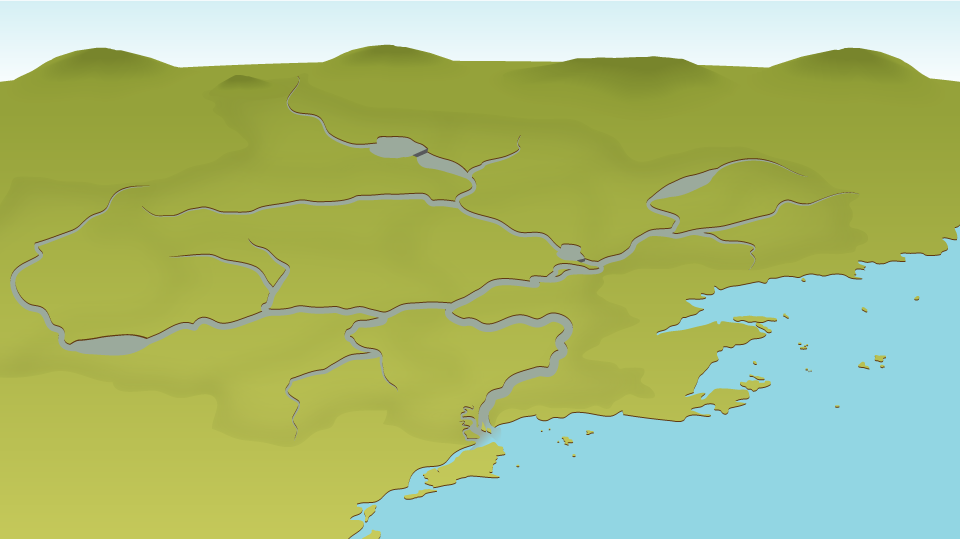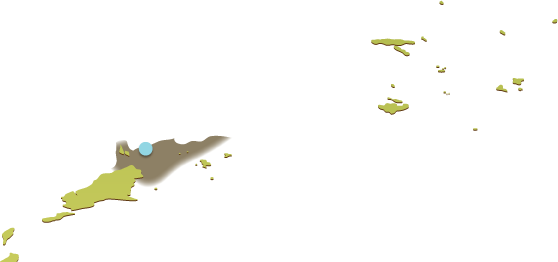





Rainfall
A long term measure of averages, patterns and variations in rain, temperature, wind, evaporation and other weather related factors
Geology
Rocks and soils and the processes by which they have been formed, change and erode
Ground Cover
Vegetation on top of the soil that protects it from erosion
Hydrology
The movement, distribution, and quality of water
Land Use
The natural or human use of a section of land or water. Current land uses across the basin are 86% for grazing; 7% for cropping; 6% for natural land uses; 5% for forestry; and 1% for urban, mining and feedlots





Poor Cropping Management
Poor pesticide application, paddock design and layout, cover management , tillage practices, pest management and fertilizer application.
Poor Grazing Management
Poor herbicide application, paddock design and layout, cover management, weed and pest management, stock control in waterways and fertilizer application.
Point Source Discharges
Single or multiple discharges releasing contaminants to the receiving waterways that do not account for the dilution capacity of passing flows or cumulative impacts downstream.
Water Use and Regulation
Poor water management like pumping waterholes that act as a refuge for fish and other biota that would usually hold permanent water dry.
Barriers to Connectivity
Dams, weirs, roads and rail infrastructure that have constructed without appropriate fishways and that block or impair the free movement of fish and other biota





Acidification
Release of sulphuric and other acids from the soil which also releases heavy metals. If concentrations are high, the acid and associated metals can impact on waterway health. pH changes are known to have adverse effects on the ionic balance and respiratory efficiency of fish and aquatic invertebrates and low pH can lead to increases in the toxicity of ammonia and heavy metals within stream sediments and a reduction in the survival rates of aquatic organisms.
Freshwater and groundwater biotic assemblages
Poor water quality and water management impacts on the population and diversity of biota including fish, waterbugs, turtles and waterbirds.
Eutrophication
High levels of nutrients such as nitrogen and phosphorus can lead to algae blooms.
Salinisation
The accumulation of large amounts of soluble salts in waterways due to natural processes as well as land clearing, mining, coal seam gas, wastewater treatment plants, and agriculture. Salinity can affect both the community structure and function of freshwater ecosystems. Elevated EC is known to influence nutrient cycling and rates of primary production and respiration. It also affects the health and survival of riparian vegetation, aquatic macroinvertebrates and fish. Increased salinity may occur due to groundwater-surface water interactions in wet years.
Sedimentation
Excess amounts of suspended particles can contribute to environmental damage, including, reduced light penetration through the water column, smothering of benthic organisms like mussels and macrophytes, irritation of fish gills and transportation of contaminants. Changes to the availability of light within the water column influences the ability of aquatic plants to photosynthesise and fix energy. Sediment enters our waterways through erosion and runoff accelerated by catchment alterations. Once in the waterways, fine sediments are readily resuspended.





Stream Flows
Streamflow and associated flooding are an important driver of waterway health. Understanding streamflow allows the Basin's water resources to be better managed. The Queensland Government provides data for hydrologic analysis, operation and management activities to ensure the productive and responsible use of natural resources and provides real time information to the Bureau of Meteorology to assist with flood forecasting services.
Mangrove and Saltmarsh Health
Mangroves and saltmarshes trap sediment and reduce silting of coastal and marine waters and associated corals and seagrasses.
Riparian Health
A riparian zone is the area between a waterway and land. These areas act as biofilters, provide shelter, shade and food for biota.
Water Quality
There are dozens of sources of waterway monitoring data across the Fitzroy Basin. The Fitzroy Partnership draws together this information, assesses and presents it in an easy to understand way to give you a clearer picture of waterway health. This comprehensive look at local river health will add to local decision-making tools that help our community achieve healthier waterways.
Water Storages
Water storages can become important dry season refugia for biota while providing water for drinking, agriculture and industrial purposes and recreational amenity.






Improved Information
Access to information can support better decision making for the adoption of improved practices
Voluntary Land Management / Stewardship
Improved waterway health can be facilitated by the voluntary adoption of improved management and is often facilitated when either a change in practice can deliver better financial returns or when co-investment from government or philanthropic avenues supports the cost associated with uptake.
Regulatory / Legislative Land Management Changes
Government can facilitate better waterway management by creating or refining regulation and policy. As a result a particular sector may need to adopt improved management as part of the ongoing licence to operate.
Rehabilitation of Land and Waterways
Rehabilitating land and waterways leads to improved waterway health. Activities include regeneration of riparian zones, increasing groundcover, controlling aquatic weeds and remediating mine sites.
Water use restrictions or alternatives
Restricting water use, managing the release of water from water storages and encouraging the adoption of technologies and practices that improve water use efficiency all help to improve aquatic ecosystem health.
Waste Water Treatment
Improvements to waterwater treatment processes at sewage treatment plants and mines can lead to a reduction in contaminants released from point source discharges.